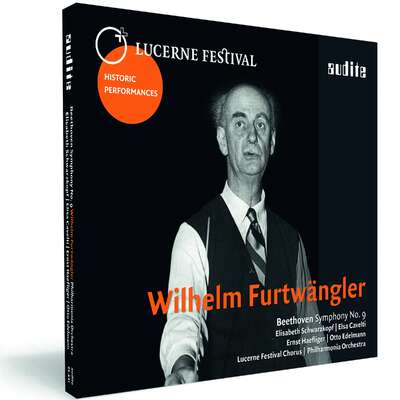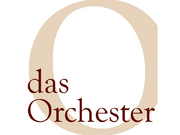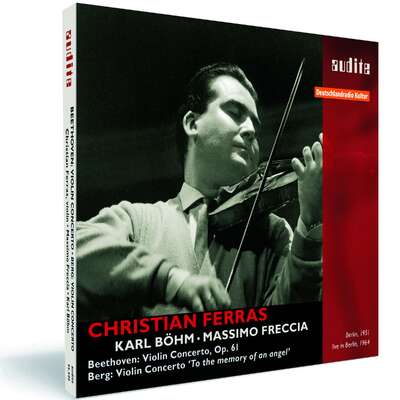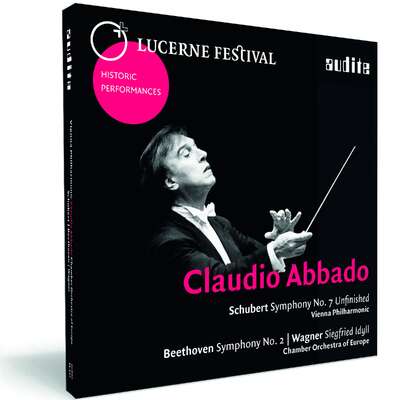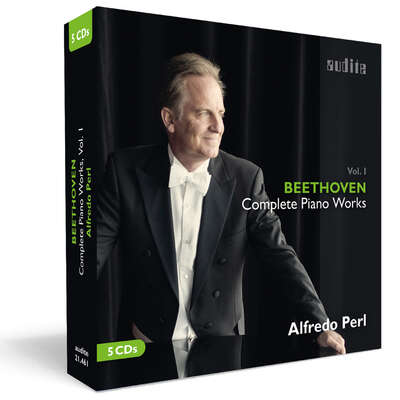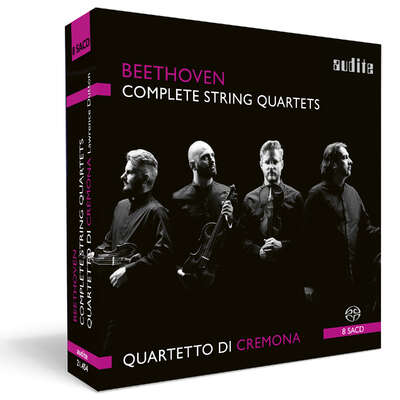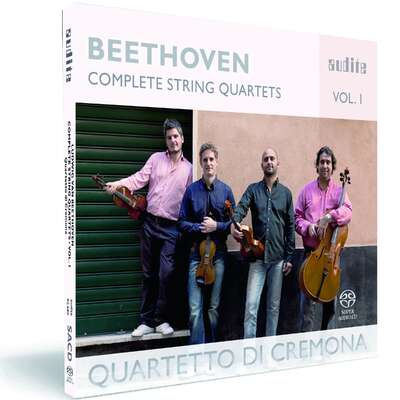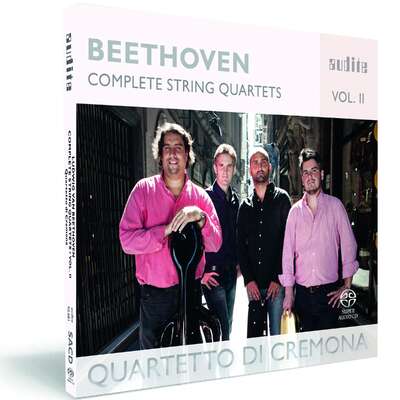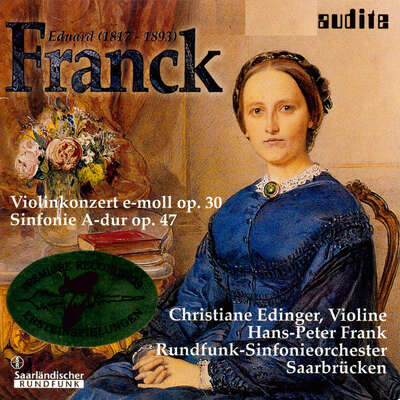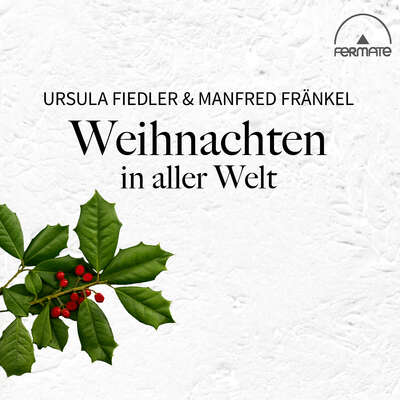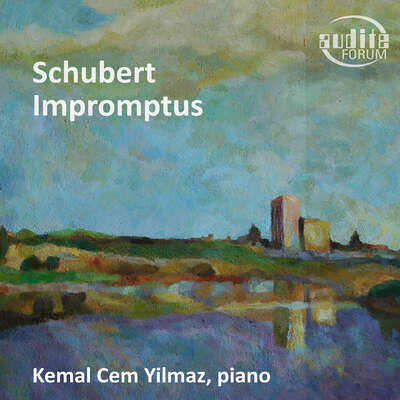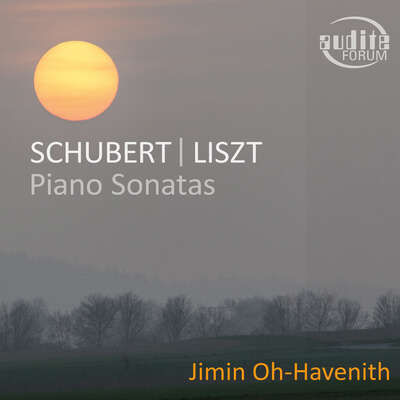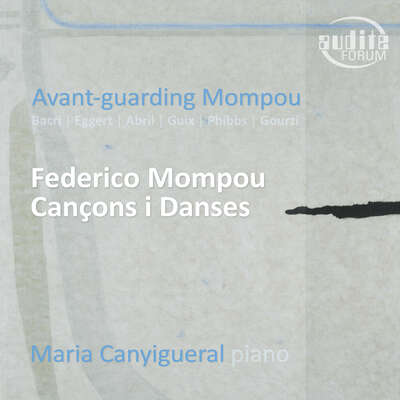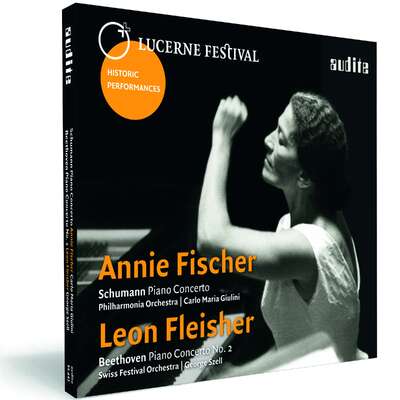
Furtwängler’s last Ninth: Wilhelm Furtwängler conducted Beethoven’s Ninth Symphony more than one hundred times. Three months before his death in 1954, he gave his last performance in Lucerne which is now newly re-mastered. Together with the superb Philharmonia Orchestra and a stellar cast of soloists, Furtwängler accentuates the visionary character of the monumental score in his passionate interpretation.more
"Die Solisten Elisabeth Schwarzkopf, die berühmte Schweizerin Elsa Cavelti, Ernst Heafliger und Otto Edelmann, der Luzerner Festspielchor sowie das Philharmonia Orchestra singen und spielen zum Niederknien aufregend. Eine aufregende aufwühlende akustische Zeitreise ins Ungeglättete, Rauhe, Elementare. Unverzichtbar!" (Der Neue Merker)
Details
|
Wilhelm Furtwängler conducts Beethoven's Symphony No. 9
LUCERNE FESTIVAL Historic Performances, Vol. 6 |
|
| article number: | 95.641 |
|---|---|
| EAN barcode: | 4022143956415 |
| price group: | BCB |
| release date: | 22. November 2014 |
| total time: | 76 min. |
Bonus Material
Informationen
LUCERNE FESTIVAL Historic Performances Vol. 6
Wilhelm Furtwängler conducts Beethoven's Ninth
Wilhelm Furtwängler conducted Beethoven's Ninth Symphony more than a hundred times. In August 1954, three months before his death, he directed his last performance in Lucerne which proved to be an "elemental musical event" (Neue Zürcher Zeitung). Alongside the brilliant Philharmonia Orchestra and a stellar cast of soloists (Elisabeth Schwarzkopf, Elsa Cavelti, Ernst Haefliger and Otto Edelmann), Furtwängler accentuates the visionary character of this monumental score: he charges the outer movements with an almost unbearable sense of suspense and interprets the lyrical passages, especially the slow third movement, cantabile and in flexible tempi. Comparing this "Lucerne Ninth" to Furtwängler's other benchmark interpretations of the Ninth - such as his famous performances in Berlin (1942) and Bayreuth (1951) - allows for a closer examination of the constants and changes in his very subjective view of Beethoven's final symphony. For the release of this concert recording as part of the series "LUCERNE FESTIVAL Historic Performances", the original tapes from the archives of SRF Swiss Radio and Television have been newly re-mastered. The pitch has been adjusted anew so that the recording, for the first time, sounds as close to the original as possible - closer than ever before. This correction in pitch not only changes the lengths of the movements, but also the dramaturgy - the 3rd movement, for example, is almost 17 seconds longer than on comparable recordings, which considerably changes the musical expression.
Wilhelm Furtwängler (1886-1954), who spent the final years of his life in Clarens on Lake Geneva, was one of the defining artists of the Internationale Musikfestwochen Luzern, today's LUCERNE FESTIVAL. Whereas Arturo Toscanini played an important role during the festival's founding years of 1938/39, Furtwängler was instrumental in establishing it as one of the then small number of great festivals. In 1944, he came to Lucerne for the first time to conduct two concerts; from 1947 - after his conducting ban had been lifted - until his death he came to Lucerne each summer (with the exception of 1952) where he enjoyed a special status.
Complete with previously unreleased photos from the festival's archive, the 32-page booklet in three languages contains extensive information on Wilhelm Furtwängler's work in Lucerne, as well as providing the context for this performance.
In cooperation with audite, LUCERNE FESTIVAL presents outstanding concert recordings of artists who have shaped the festival throughout its history. The aim of this CD edition is to rediscover treasures - most of which have not been released previously - from the first six decades of the festival, which was founded in 1938 with a special gala concert conducted by Arturo Toscanini. These recordings have been made available by the archives of SRF Swiss Radio and Television, which has broadcast the Lucerne concerts from the outset.
Carefully re-mastered and supplemented with photos and materials from the LUCERNE FESTIVAL archive, they represent a sonic history of the festival:
This release is furnished with a „producer's comment" by producer Ludger Böckenhoff on www.audite.de/en/product/CD/95641/multimedia.
Reviews
www.opusklassiek.nl | december 2017 | Aart van der Wal | December 1, 2017 | source: https://opusklas...
Waar nog bijkomt dat de nieuwe remastering tot een aanmerkelijk beter klankresultaat heeft geleid.Mehr lesen
SRF2 Kultur
| Donnerstag, 7.1.2016, 22.00 – 24.00, SRF2 Kultur | Nik Broda | January 7, 2016
Historic Performances: Furtwänglers letzte Neunte
Wilhelm Furtwängler am Lucerne Festival von 1954
Diese beiden Aufführungen sind zu einem elementaren Vermächtnis des Dirigenten geworden. Das Schweizer Radio war damals dabei und diese Aufnahme gibt es jetzt remastered als Coproduktion mit Radio srf2.kultur.Mehr lesen
klassik.com
| 29.11.2015 | Konstantin Parnian | November 29, 2015 | source: http://magazin.k...
Großer Name, kleine Tat
Beethoven, Ludwig van - Symphonie Nr. 9 op. 125
Besonders die klangliche Balance zwischen Chor und Solisten ist beeindruckend gelungen.Mehr lesen
Gauchebdo
| 15 octobre 2015 | Myriam Tetaz-Gramegna | October 15, 2015
Des concerts qui ont marqué leur époque
La 9ème de Beethoven par Furtwaengler et des concertos par Annie Fischer et Leon Fleischer s'ajoutent à l'Histoire sonore du festival de Lucerne chez Audite.
Ces deux disques ouvrent des perspectives parfois inattendues sur des oeuvres qu’on croit connaître.Mehr lesen
Neue Zürcher Zeitung | 28.08.2015 | tsr | August 28, 2015
Lucerne Festival Historic Performances – Furtwänglers Neunte
Der Luzerner Festwochenchor zeigt sich seiner Aufgabe bestens gewachsen und schleudert das «Seid umschlungen, Millionen» mit viel Pathos heraus
Der Luzerner Festwochenchor zeigt sich seiner Aufgabe bestens gewachsen und schleudert das «Seid umschlungen, Millionen» mit viel Pathos heraus. Das mit grossen Namen besetzte Solistenquartett kann sich im Strudel des Geschehens prächtig behaupten.Mehr lesen
Stereo (Japan) | June 2015 | June 1, 2015
Japanische Rezension siehe PDF!Mehr lesen
Fanfare | Ma 2015 | Henry Fogel | May 1, 2015
This famed performance was Furtwängler’s last of the Ninth; he died a few months later. I have reviewed it many times in Fanfare: Music & ArtsMehr lesen
Interested readers can look up those earlier reviews in the Fanfare Archive, and I will not go into great detail here about the performance, other than to say that over the years it has become my own favorite of the 12 that have survived (all are live; Furtwängler never made a studio recording of this work). Overall it can be said to combine the intensity and drama of his earlier versions with a certain nobility and restraint not always present in those. It is, of course, helped by the fine recorded sound. The slow movement in particular here is magical; one never feels a bar line, rather it is one long arch. Anyone interested in this music, no matter what your performance style preference might be, should hear this statement of immense musical grandeur and power.
For collectors, the important question will be how this compare to the Tahra and Pristine issues, both of which are of excellent quality. I would say that for most listeners, the differences will not be significant, and if you own either the Tahra or Pristine version this is not an essential purchase. (Tahra has folded, which eliminates one option for those who don’t own it.) I have spent the better part of a weekend comparing the three versions, and would say that I have a slight preference for this Audite version, so a collector who deeply cares about this performance and absolutely wants the most satisfying transfer might wish to explore it. I find the orchestral sound just a bit more natural and less congested, more fully open.
One issue is the equalization applied by the transfer engineers. Andrew Rose of Pristine felt that there was a bit too much mid-bass on the Tahra (I am paraphrasing), which made the timpani overly prominent. He suggested a point of comparison at about 10:00 into the first movement, and so I directly compared that spot (from about 9:55 to about 11:10) in all three versions, in addition to listening to the entire performance in all three transfers. Rose was right: The Tahra does seem a bit boomy, and his compensation was an improvement. But one could make the case that he went too far, and that this Audite release finds the proper middle ground. Both in that one-minute passage, and in hearing the entire performance, I found the Audite to be slightly more satisfying as a listening experience. But I will stress again that the differences are not major.
Also not major, but present, are the pitch/speed differences. Audite and Pristine are extremely close (for all practical purposes, identical); Tahra is transferred at a very slightly faster speed. The pitch difference is not consciously audible, but could be affecting one’s reaction to the overall sonority of the orchestra. Here are the timings of each movement, not as given in the booklet, but as measured from first note to end of last note of each movement:
Audite’s notes are excellent, though not always perfectly translated into idiomatic English. What is most gratifying is that this is another assurance that this historic performance will remain available to the public in the best possible form.
American Record Guide | May 2015 | Paul L Althouse | May 1, 2015
Furtwängler conducted the Ninth more than 100 times, of which about a dozen were recorded; none of these was done in studio (which he disliked onMehr lesen
This is, on the whole, a very fine performance and a good representation of Furtwängler’s approach to the work. The very beginning has some rough moments of ensemble, but the Philharmonia settles in and plays quite well. The first movement has the gravity and seriousness we expect from the conductor, and the slow movement includes many transcendent moments, particularly in the junctions between themes. The finale is expertly gauged. The main theme begins almost inaudibly, and the build to a frenetic ending is very convincing. Chorus and soloists are all in good shape.
Particularly with the fine sonics, this issue merits a recommendation, though I think I would prefer the similar 1951 Bayreuth performance, which is a little quicker and creates a better sense of occasion. Also in the running would be a white-hot war-time performance (Berlin, 1942), which probably shows Furtwängler at the height of his power and imagination.
Das Orchester | 05/2015 | Arnold Werner-Jensen | May 1, 2015 | source: http://www.dasor...
Wie wird man einer solchen über sechzig Jahre alten Liveaufnahme gerecht?Mehr lesen
Musik & Theater | 05/06 Mai/Juni 2015 | Werner Pfister | May 1, 2015 Lebendige Vergangenheit
Die Veröffentlichung historischer Tondokumente vom Lucerne Festival – damals Internationale Musikfestwochen Luzern – ist beim Label Audite in besten Händen. [...] Beethovens Neunte unter Furtwängler dürfte, obwohl bereits unzählige andere Mitschnitte vorliegen, ein Muss nicht nur für eingefleischte Furtwängler-Fans sein: Es handelt sich um seine letzte Aufführung des Werks; nur drei Monate später starb er. Der Mitschnitt ist beeindruckend – in den breiten Tempi, im ungemein souveränen musikalischen Fluss, in der typisch Furtwängler'schen Dramaturgie des Augenblicks sowie – last but not least – in der Leistung der Mitwirkenden. Bekanntlich hat der Maestro Beethovens Neunte nie im Studio eingespielt, und seine hier dokumentierte letzte Aufführung ist in jeder Hinsicht Massstab und Vermächtnis.Mehr lesen
Classica – le meilleur de la musique classique & de la hi-fi | n° 170 mars 2015 | S.F. | March 1, 2015 Également Recus
La plus-value sonore est indéniable dans la Neuvième Symphonie de Beethoven qu'Audite réédite sous la baguette de Wilhelm Furtwängler. [...] Très beau travail éditorial pour cette version qui se place dans le trio des gravures légendaires du chef allemand (avec les témoignages berlinois de 1942 et de Bayreuth de 1951).Mehr lesen
BBC Music Magazine | March 2015 | Erik Levi | March 1, 2015
Audite have worked miracles in bringing such presence to this live 1954 recording. Despite some minor imperfections of orchestral ensemble,Mehr lesen
thewholenote.com
| March 2015 | Bruce Surtees | February 27, 2015
Old Wine, New Bottles
Fine Old Recordings Re-Released
Wilhelm Furtwängler’s final performance of the Beethoven Ninth was inMehr lesen
www.amazon.de | 21. Februar 2015 | February 21, 2015 | source: https://www.amaz... "Enthüllet den Gral!" – Furtwänglers letzte Neunte
Nachdem Audite mit seiner Edition von Furtwänglers Live-Rias-Aufnahmen (2009) bei mir gemischte Gefühle hinterlassen hatte, war ich eher skeptisch,Mehr lesen
Für die neue Veröffentlichung des legendären Konzerts, in dem Furtwängler letztmalig Beethovens Neunte leitet, spricht zunächst einmal, daß erstmals auf die Originalbänder des Schweizer Rundfunks zurückgegriffen wurde. Doch weitaus gravierender fällt das Remastering ins Gewicht. Im Vergleich zur Tahra-Ausgabe ist die neue SACD um einige Störgeräusche bereinigt worden. Das wird bereits in den ersten zwei(!) Sekunden des Kopfsatzes deutlich. Insgesamt ist der Audite-Klang deutlich besser als bei der Rias-Edition, und mit Blick auf Tahra hat die neuere SACD sogar noch an räumlicher Tiefe gewonnen.
Furtwänglers letzte Auseinandersetzung mit der neunten Sinfonie Beethovens ist eine der überragenden im Kanon seiner hinterlassenen Aufnahmen. Mehr als ein Dutzend Mitschnitte sind dokumentiert, doch drei davon stechen hervor: die energische Neunte vom März 1942 , die feierliche von der Eröffnung der Bayreuther Festspiele (1951) und der vorliegende Mitschnitt. Er ist Furtwänglers Vermächtnis. Die Interpretation spiegelt die Empfindungen eines entkräfteten Künstlers wider, dessen Glauben an die Musik einzig ungebrochen ist. Drei Monate nach der Aufführung wird der des Lebens müde Furtwängler an den Folgen einer Lungenentzündung sterben.
So ist diese letzte Neunte des großen Romantikers ein finales Bekenntnis dafür, was Musik ihm bedeutete. In seinen Augen war sie universell, humanistisch und ideell. Das Konzert erinnert mich daher an Wagners Parsifal. "Enthüllet den Gral!", heißt es dort. Und plötzlich sind da nur noch das Heiligtum, die Menschen und der reine Glaube, der sie verbindet. Diesen Moment erschafft Furtwängler hier ein letztes Mal. Er enthüllt den Gral – vielleicht wahrhaftiger und natürlicher und einzigartiger als jemals zuvor. Die klanglich großartig remasterte SACD von Audite legt über das Live-Ereignis Zeugnis ab.
(Das Begleitheft ist in deutscher, englischer und französischer Sprache.)
Musica | N° 263 - febbraio 2015 | Maurizio Modugno | February 1, 2015
Se una partitura ha contribuito in modo determinante all’edificazione delMehr lesen
Record Geijutsu | 2015.2 | February 1, 2015
japanische Rezension siehe PDF!Mehr lesen
Gramophone | February 2015 | Rob Cowan | February 1, 2015
Character in abundance, spellbinding results
Recordings by some piano and conducting greats from the past gathered into handy collections of various sizes
[…] On the orchestral front, Audite's 'new remastering from original analogue tape' of Beethoven's Choral as performed at the Lucerne Festival onMehr lesen
www.ClassicsToday.com | 21.01.2015 | David Hurwitz | January 21, 2015 Historical Gems: Furtwängler’s Lucerne Ninth, Again
This performance of Beethoven’s Ninth is unquestionably the best that Furtwängler left us. It has all of his customary passion and spontaneity, but with really fine playing and singing.Mehr lesen
http://operalounge.de | 01.01.2015 | Rüdiger Winter | January 1, 2015 Furtwänglers letzte
Wilhelm Furtwängler hat sich zeitlebens mit Beethovens Neunter auseinander gesetzt. Er hat das Werk nach Recherchen des Musikpublizisten HerbertMehr lesen
Furtwängler hatte die Sinfonie 1954 zweimal aufgeführt. Das erste Konzert fand am 21. August statt. Es spielt das von EMI-Chefproduzent Walter Legge ursprünglich als reines Schallplattenochester gegründete Philharmonia Orchestra London, es singt der Festivalchor Lucerne. Die Solisten sind Elisabeth Schwarzkopf (Sopran), Elsa Cavelti (Alt), Ernst Haefliger (Tenor) und Otto Edelmann (Bass). Ein Vierteljahr nach dem Gastspiel, nämlich am 30. November, ist Furtwängler gestorben. Von zunehmender Schwerhörigkeit geplagt, vom schwierigen Neubeginn nach dem Ende des Nationalsozialismus mit dem zähen Entnazifizierungsverfahren zermürbt, soll ihn der Lebenswille verlassen haben.
Es ist darüber spekuliert worden, ob das nahe Ende in dem Konzert gar schon anklingt. Im Nachhinein weiß man es immer besser. So verführerisch derlei Gedankenspiele sind, ich halte davon nichts. Dafür gibt es zu viele Übereinstimmungen mit vorangegangenen Aufnahmen. Etwa mit der Aufführung der Sinfonie bei der Eröffnung der ersten Bayreuther Festspiele nach dem Krieg am 29. Juli 1951. Der Mitschnitt ist offiziell bei der EMI herausgekommen und immer wieder neu aufgelegt worden. Die Schwarzkopf und Edelmann waren auch schon dabei. Der unbestimmte, zögernde, ja nervöse Beginn, wie ihn nur Furtwängler hinbekam, das breite Zeitmaß, das hintergründige Scherzo mit den harten, erbarmungslosen Pauken, das hingebungsvolle Adagio, in dessen Verlauf die Zeit stehen zu bleiben scheint, der Mut zu Pausen, in denen sich die Spannung bis zur Unerträglichkeit aufbaut, die Wucht des Finales mit dem rasenden Einstieg, den peitschenden Becken, dem Drängen, der beängstigenden Eile zum Schuss hin. Das exklusive Solistenquartett, aus dem sich die einzelnen, sehr individuellen Stimmen deutlich herausheben und der Chor stehen genau so unter Furtwänglers Bann. Sie sind wie angesteckt. Mehr geht nicht. Ist der letzte Ton verklungen, ist es auch wie eine Erlösung. Länger hält man Furtwänglers Hochspannung nicht aus.
www.klassikerleben.de
| 01.01.2015 | Oliver Buslau | January 1, 2015
Wilhelm Furtwängler
Luzern Festival
Es war ein Konzert im Rahmen des Festivals von Luzern, bei dem Furtwängler eine Interpretation gelang, die zu den spannendsten gehören dürfte, die es von diesem Werk überhaupt gibt – und die übrigens in deutlichem Kontrast zu den anderen Furtwängler-Dokumenten steht. [...] Das 32-seitige Booklet informiert ausführlich über Furtwänglers Wirken in Luzern – ergänzt mit vielen, bisher unveröffentlichten Fotos aus dem Festivalarchiv.Mehr lesen
Opera Nederland | januari 2015 | January 1, 2015
Voor puristen die hun verzameling willen completeren en fans van Wilhelm Furtwängler!Mehr lesen
Schwäbische Zeitung | Samstag, 20. Dezember 2014 | man | December 20, 2014 Festspielklänge aus Luzern
Eine CD-Reihe zur Geschichte der Luzerner Festspiele bringt das LabelMehr lesen
www.SA-CD.net | December 13, 2014 | Polly Nomial | December 13, 2014
A (rightly) feted account from Furtwangler shortly before his (relatively)Mehr lesen
Record Geijutsu | 12/2014 | December 1, 2014
Japanische Rezension siehe PDF!Mehr lesen
Intoxicate | 12/2014 | December 1, 2014
Japanische Rezension siehe PDF!Mehr lesen
http://issuu.com | December 2014 | Highresaudio | December 1, 2014
Alongside the brilliant Philharmonia Orchestra and a stellar cast of soloists [...] Furtwängler accentuates the visionary character of this monumental score Mehr lesen
www.pizzicato.lu | 27/11/2014 | Remy Franck | November 27, 2014 Furtwänglers letzte Neunte
Von Wilhem Furtwängler existieren etliche Aufnahmen von Beethovens 9. Symphonie, und alle sind auf allerhöchstem interpretatorischem Niveau. WelcheMehr lesen
Konkret heißt das, dass es im 1. Satz sehr viele hörbare Unstimmigkeiten gibt, und der 2. Satz eher zögerlich gespielt wird. Erst ab dem Adagio beginnt der Zauber zu wirken, und es kommt zu einem Spiel von größter musikalischer Intensität. Der Luzerner Festspielchor singt auf gehobenem mittleren Niveau, während das Sängerquartett mit Schwarzkopf, Cavelti, Haefliger und Edelmann zu den besten gehört, die wir kennen.
Es ist dies ein Mitschnitt von Furtwänglers letztem Auftritt mit der Neunten, drei Monate später starb der große Dirigent. In diesem Sinne ist diese Aufnahme mehr ein historisches Dokument als eine wirkliche Referenzeinspielung.
When Furtwängler conducted his last performances of Beethoven’s Ninth Symphony, he and the Philharmonia Orchestra needed some time to adjust, so that the playing becomes extraordinary only from the Adagio on. So, consider this rather as an important historical document than as a premium musical experience.
Infodad.com | November 26, 2014 | November 26, 2014 For specialized tastes
Audite has remastered the live recording from the original tapes, and has generally done a fine job; and Furtwängler was usually at his best in live performances rather than in the recording studio. So this is a version of the Ninth that is about as good a reflection on Furtwängler and his legacy as anyone is likely to get. [...] It has all the trademarks of intensity and emotional expressiveness associated with Furtwängler, and also his trademark capriciousness with tempos and sometimes even with rhythms.Mehr lesen
The Herald Scotland | Sunday 23 November 2014 | Michael Tumelty | November 23, 2014
[...] there is a visionary, epic quality to the performance, from the monumental drama of the opening movement, the sea of serenity Furtwangler conjures in the great slow movement, and the seismic crash at the launch of the finale.Mehr lesen
Der neue Merker
| November 2014 | Dr. Ingobert Waltenberger | November 1, 2014
Furtwängler dirigiert seine letzte IX. Beethoven in Luzern:
Jenseits der Träume – Audite veröffentlicht die sorgfältigst restaurierten Masterbänder in der Serie Historische Aufführungen des Luzern Festivals
Die Solisten Elisabeth Schwarzkopf, die berühmte Schweizerin Elsa Cavelti, Ernst Heafliger und Otto Edelmann, der Luzerner Festspielchor sowie das Philharmonia Orchestra singen und spielen zum Niederknien aufregend. Eine aufregende aufwühlende akustische Zeitreise ins Ungeglättete, Rauhe, Elementare. Unverzichtbar!Mehr lesen
Audio Technique | 11/2014 | Stephen | November 1, 2014
chinesische Rezension siehe PDF!Mehr lesen

